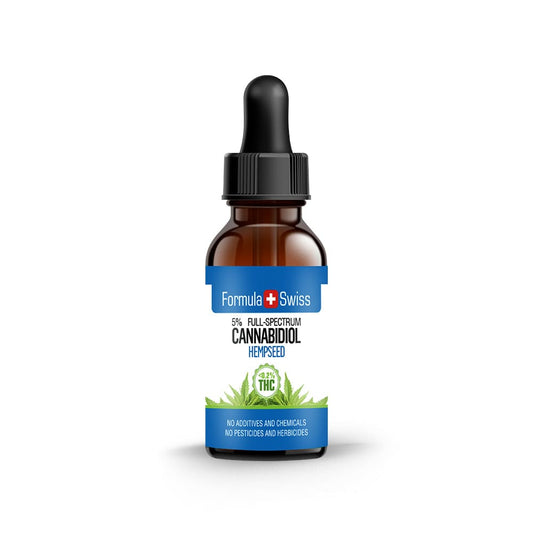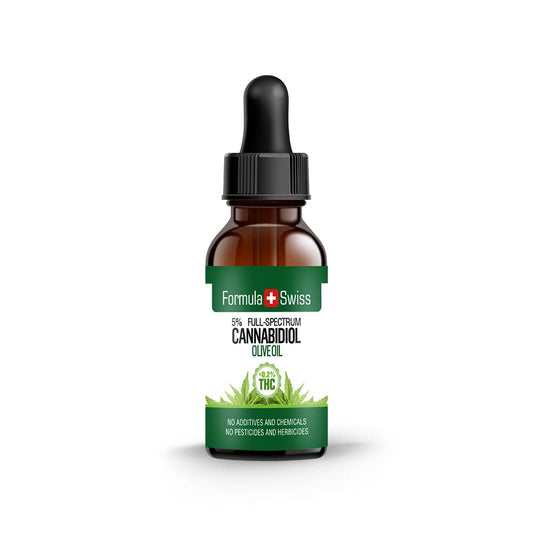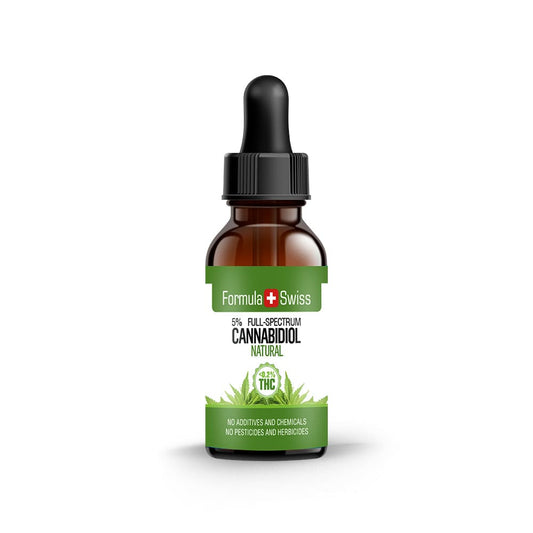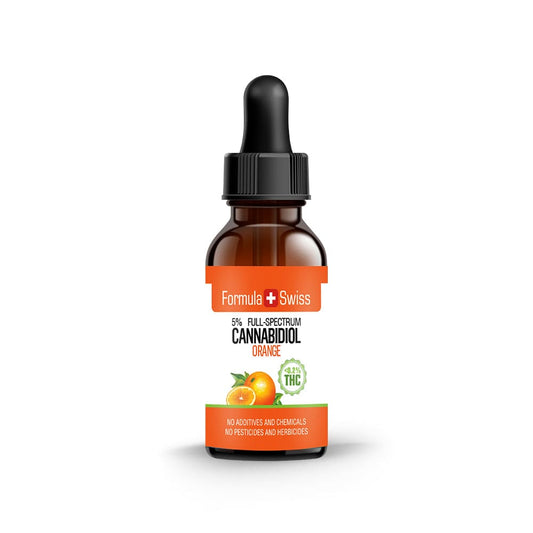CBV, or cannabivarin, is a naturally occurring cannabinoid found in small amounts in the cannabis plant. It belongs to the varin group, which includes compounds that have a slightly shorter side chain than more common cannabinoids.
CBV is non-intoxicating and is considered a neutral cannabinoid, meaning it does not bind to receptors in the same way as THC. At Formula Swiss, I’ve spent over a decade working closely with cannabinoids, and CBV has always caught my attention for its subtle role in the plant’s development.
It typically forms as THCV breaks down over time through oxidation. This makes it more likely to appear in older extracts or dried plant material. Although research into CBV is still at an early stage, I find it important to understand how these lesser-known compounds shape the overall profile of full-spectrum products.
Learning about CBV gives me more insight into the natural changes that take place as the plant matures and how each compound plays its part.
Save up to 30% when you order your CBD oil today
Key takeaways
- CBV is a minor cannabinoid found within the cannabis plant, with distinctive structural and potential therapeutic qualities.
- Despite its lower prevalence compared to THC and CBD, cannabivarin is gaining recognition within the cannabis industry for its unique applications.
- CBV's molecular structure, while similar to THC and CBD, poses different experiences and uses, which are just starting to be explored.
- Understanding CBV's role in the evolving industry of cannabinoids is crucial for stakeholders looking to leverage the full spectrum of cannabis compounds.
This article is provided for informational purposes only and does not relate to any of the products available in our webshop. For more information, please see our full disclaimer.
Introduction to CBV (Cannabivarin) and its significance
Cannabivarin, or CBV as it’s often called, has recently started to catch the eye of researchers looking into cannabinoids. Unlike the more familiar THC and CBD, CBV offers something a little different. It’s opening up fresh ways of thinking about how cannabinoids might be used in day-to-day life.
From what I’ve seen, CBV is turning up in more conversations about product development. While it’s still early days, people are studying how it might enhance certain products and offer something distinctive. You’ll find it being tested in areas ranging from personal wellness to more targeted applications, all adding to its growing relevance.
| Potential CBV applications | User experience focus |
|---|---|
| Vape products designed for a pick-me-up | Quick and energising sensation |
| Capsules aimed at supporting daily wellness routines | Gradual support as part of long-term use |
CBV is starting to stand out in cannabinoid research, drawing interest for the distinct ways it might be applied. While it’s still early days, its potential is already sparking curiosity among both professionals and everyday users.
Exploring the chemical structure of CBV
CBV, or cannabivarin, is a non-psychoactive cannabinoid that shows up only in very small amounts in Cannabis sativa. What makes CBV structurally distinct is its three-carbon side chain (known as a propyl group), unlike the five-carbon chain typically found in THC or CBD. This places CBV in the "varin" class of cannabinoids.
Its formal chemical name is 6,6,9-Trimethyl-3-propyl-6H-benzo[c]chromen-1-ol, with a molecular formula of C₁₉H₂₂O₂. One of the more interesting points about CBV is that it's considered the oxidative version of THCV (tetrahydrocannabivarin), similar to how CBN forms when THC degrades.

During this oxidation, hydrogen atoms are removed, resulting in the formation of additional double bonds within the molecule. This structural alteration may affect how CBV interacts with cannabinoid receptors, though scientists are still working to understand these interactions in detail.
What is THC (Tetrahydrocannabinol)?
Comparison with THC and CBD
CBV shares some similarities with THC, but it behaves quite differently. It doesn’t cause a high like THC, and its actions in the body don’t follow the same patterns as CBD either. This gives CBV its own space in the cannabinoid profile and makes it a subject worth watching.
The table below outlines how CBV compares to THC and CBD in terms of structure and observed characteristics:
| Cannabinoid | Chemical structure | Psychoactive effects | Observations |
|---|---|---|---|
| CBV (Cannabivarin) | Structurally similar to THC, with a shorter side chain | Non-psychoactive | Still being studied, with distinct behavioural traits |
| THC (Tetrahydrocannabinol) | Five-ring base with a phenol group | Psychoactive | Commonly associated with mood and perception changes |
| CBD (Cannabidiol) | Shares a similar backbone with slight structural differences | Non-psychoactive | Often noted for its broad investigational potential |
Which cannabinoids produce a psychoactive effect?
The importance of cannabivarin's unique structure
What sets CBV apart lies in its molecular structure. The shorter side chain plays a noticeable role in how it behaves in the body, especially when compared to THC and CBD. It's one of those small changes that can make a big difference in how a cannabinoid interacts with different systems.
I've learned that this distinct structure has opened the door to new ways of thinking about cannabinoid formulation. While it doesn’t have the same profile as more familiar compounds, CBV's characteristics suggest it could be a useful ingredient in future product development, particularly for those wanting options without the intoxicating effects.
Order and get up to 30% off your CBD oil
Historical context of CBV research
Cannabivarin (CBV) came to attention during analytical work on cannabis, where it was noted as a potential byproduct of THCV breakdown. Although there’s no precise record of when or by whom it was first isolated, CBV has featured in cannabinoid profiling studies since the latter part of the 20th century.

Early on, scientists began noticing CBV during routine testing and saw it as a compound worth following up. That initial interest led to more focused efforts to understand how it forms and how it differs from more prominent cannabinoids like THC and CBD.
As research continued, CBV’s distinct characteristics started to stand out. While there's still much to learn, these findings have encouraged further investigation, giving researchers a clearer picture of CBV’s place within the broader cannabis chemistry.
| Year | Discovery | Impact |
|---|---|---|
| 1970s | Discovered in 1971 as one of the cannabinoids in hashish | Laid the groundwork for further cannabinoid research. |
| 1990s | Limited research; no significant advancements in understanding CBV's chemical structure or receptor interactions. | CBV remained a lesser-studied cannabinoid with minimal focus in scientific literature. |
| 2000s | No substantial clinical studies or therapeutic studies specific to CBV were conducted. | CBV's potential medical applications remained largely unexplored during this period. |
What is THCV (Tetrahydrocannabivarin)?
Current scope and opportunities in CBV research
Interest in CBV is growing across different areas of study. Researchers are exploring what this cannabinoid can tell us and how it might be used in wellness-focused formulations. From what I’ve seen so far, CBV holds potential that’s only just beginning to be understood.
Potential fields of application
I’ve noticed increasing attention on how CBV interacts with the body, especially in areas linked to the nervous system and overall well-being. Its presence tends to surface during cannabinoid profiling, and it’s catching interest for its possible role in calming or recovery-based blends.
- Investigations into nervous system support
- Research into calming and recovery-based products
- Trials of plant-based formulations for physical comfort
Challenges in cannabivarin research
Still, there are some major hurdles to overcome. Based on what I have found, one of the toughest parts is isolating CBV from the plant itself. It shows up in such small amounts that extracting it takes time, precision, and significant resources.
The technical side of things can be demanding. From advanced analytical tools to the need for consistent material, working with CBV isn’t straightforward. It’s a reminder that not all cannabinoids are easy to study, especially those that don’t occur in abundance.
What’s clear to me is that progress will rely on collaboration. By combining insights across different areas of expertise, we stand a much better chance of understanding CBV more fully and finding thoughtful ways to explore its potential.
Order CBD oil now and save as much as 30%
Sourcing and extraction methods for CBV
When it comes to CBV extraction, the methods used are very important. They help make sure the final product is pure and strong. Getting CBV from hemp plants needs a lot of skill and knowledge of plants and chemicals.

- First, the plant material, like flowers, leaves, and stems, is carefully picked. This makes sure only the best materials are used.
- Then, a special method, like using alcohol to extract, is used. This pulls out cannabinoids, terpenes, and other good stuff from the plant.
- After that, the extracted stuff goes through a cleaning process. This removes bad things and makes the CBV stronger.
- At every step, tests are done to check if the CBV is working well.
This careful way of getting CBV is important for its quality and use. It helps make sure it's good for research and new products. Following rules and guidelines is crucial for this.
How are cannabinoids extracted from cannabis plants?
Potential utilisation paths for CBV
Looking into Cannabivarin (CBV) opens up fresh possibilities for both product development and research. With progress in technology and biotechnology, we're beginning to see just how far cannabinoid science can go.
Technological innovations and biotechnological advancements
Recent advances in cannabinoid technology have made it simpler to isolate and study CBV more effectively. These tools are helping to reveal the compound’s full potential, offering better ways to explore its properties and future applications.
Creating value-added products with cannabivarin
Creating products with CBV means understanding both its unique characteristics and what people are looking for. Each product is shaped by how CBV behaves and the practical needs of users.
From topical creams to daily-use supplements, these items are made to fit different routines and preferences, always with the goal of making the most of what CBV has to offer.
- Enhanced dietary formats
- Topical applications tailored to skin support
- Blended formulations developed with focus and clarity in mind
CBV's growing role in product development reflects real progress in research. It paves the way for continued innovation. With a strong commitment to quality and thoughtful design, CBV could reshape how we think about wellness and everyday health.
Role of CBV in the broader cannabis market
As an industry expert, I've seen the CBV market grow. Cannabivarin, or CBV, is now essential in the cannabis industry. This is because people want more tailored cannabis experiences and products.
This change shows how the market is moving towards using more than just THC and CBD. Many other cannabinoids are being discovered for their special application.

CBV's role is not just changing things; it shows the market is growing up. It wants more complex and precise products.
Looking at the trends, the industry is exploring new ways to use cannabinoids. There's a big push for research to find new uses for CBV. This is making the market more diverse and inclusive.
I think CBV's role is vital for the cannabis industry's future. It's shaping new strategies and products. This makes CBV an important cannabinoid in the cannabis industry.
Real-world applications and consumer products containing CBV
CBV is increasingly finding its place in modern wellness routines, with new applications emerging across different lifestyle categories. Cannabivarin (CBV) stands out for its distinctive profile and is being explored in the development of various consumer products.
As interest in alternative cannabinoids grows, CBV is gradually becoming a talking point in personal care and daily wellness tools. This shift reflects changing consumer preferences and an openness to exploring a broader range of plant-based options.
New formulations, such as supplements and vapour blends, demonstrate how CBV is being incorporated into everyday items. These developments come from ongoing product design efforts, aiming to support users in building more structured and intentional habits.
User impressions play an important role in how CBV is being refined and positioned. Feedback from early adopters helps guide product makers to align with preferences and practical use cases, rather than focusing on outcomes.
| Product type | Description | Consumer feedback |
|---|---|---|
| Lifestyle supplements | Formulated with CBV to complement mindful routines and balanced habits. | Users mention a sense of support in their daily structure and routines. |
| Focus-inspired vapes | Designed for moments that call for clarity and intentional engagement. | Some users report a clearer headspace during routine or creative tasks. |
Thanks to shared experiences and feedback, CBV-based products continue to evolve. As personal wellness goals shift, CBV is being explored in ways that reflect those changing needs, from supportive tools to new formats for conscious living.
Future directions for CBV research and development
Exploring the future of CBV research is a genuinely exciting path. The more we look into it, the clearer it becomes that cannabivarin holds unique possibilities across a range of applications. Its distinct profile continues to spark curiosity within cannabinoid studies.
Ongoing interest and growing support for CBV-focused research are likely to encourage fresh ideas and new developments. As more projects take shape, there’s an opportunity to see where CBV might fit within broader innovation, from product formulation to cultivation techniques that highlight its unique characteristics.
There’s a noticeable shift towards exploring rare cannabinoids such as CBV, particularly in sectors looking to expand their approach to formulation and targeted development. This interest is grounded in previous findings and is being fuelled by evolving methods and increased awareness of cannabinoid diversity.
Personal perspective
In my experience working with refined cannabis extracts, CBV has always caught my eye as one of those subtle cannabinoids that’s easy to overlook unless you’re paying close attention. It tends to show up only in very small amounts, often in samples where THCV has started to oxidise.
I’ve noticed it most often during lab reviews of older material, especially when tracking how compounds change over time. CBV sits within the varin group, which means it has a shorter side chain than compounds like THC or CBD. That one structural detail gives it a different profile and changes how it behaves.
What fascinates me most about CBV is that it feels like a quiet marker of the plant’s ageing process. To me, it acts a bit like a timestamp, showing signs of both natural progression and how the extract was handled after harvest. Whenever it turns up on a certificate of analysis, I take a moment to reflect.
It’s a reminder that the chemistry of cannabis is still full of layers we’re only beginning to understand.
Don’t miss out—save up to 30% when you purchase CBD oil today
Frequently asked questions
What is cannabivarin (CBV)?
Cannabivarin (CBV) is a non-intoxicating cannabinoid found in trace amounts in cannabis, formed through the degradation of tetrahydrocannabivarin (THCV). It is classified as a varin-type cannabinoid due to its shortened three-carbon side chain.
Is CBV psychoactive?
CBV is not considered psychoactive and does not produce intoxicating effects. It has low affinity for cannabinoid receptors associated with psychoactivity.
How is CBV different from other cannabinoids like THC or CBD?
CBV differs from THC and CBD in its molecular structure, specifically its varin side chain, and is a degradation product rather than a primary cannabinoid. It is present in much smaller quantities and is less researched.
Are there any side effects of CBV?
There are no documented side effects of CBV due to the lack of comprehensive human studies. Its safety profile remains largely unknown.
How is CBV produced or extracted?
CBV can be extracted from cannabis using standard methods such as CO₂ or solvent extraction, although its low concentration makes isolation more complex. It can also be obtained through the oxidation of THCV.
Can CBV be found in full-spectrum cannabis products?
CBV may be present in full-spectrum cannabis products, particularly those derived from strains with notable THCV content. However, its concentration is typically very low.
Does CBV show up on drug tests?
CBV is unlikely to be detected in routine drug tests, which focus on identifying THC and its metabolites. It does not produce the same metabolic markers as THC.
Can CBV be synthesised in a laboratory?
Yes, CBV can be synthesised in a laboratory setting from precursor cannabinoids. Chemical synthesis allows for controlled study and potential formulation.
Is CBV found in all cannabis strains?
CBV is not found in all cannabis strains and tends to appear in those with higher THCV levels. Its occurrence is generally limited to specific chemotypes.
Why is there limited information about CBV?
Information about CBV is limited due to its low natural abundance and minimal inclusion in early cannabinoid research. It has only recently begun to attract scientific interest.






